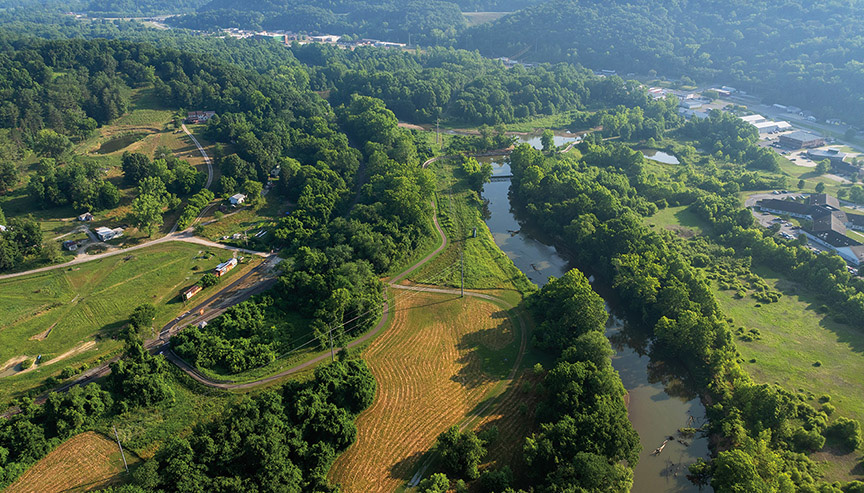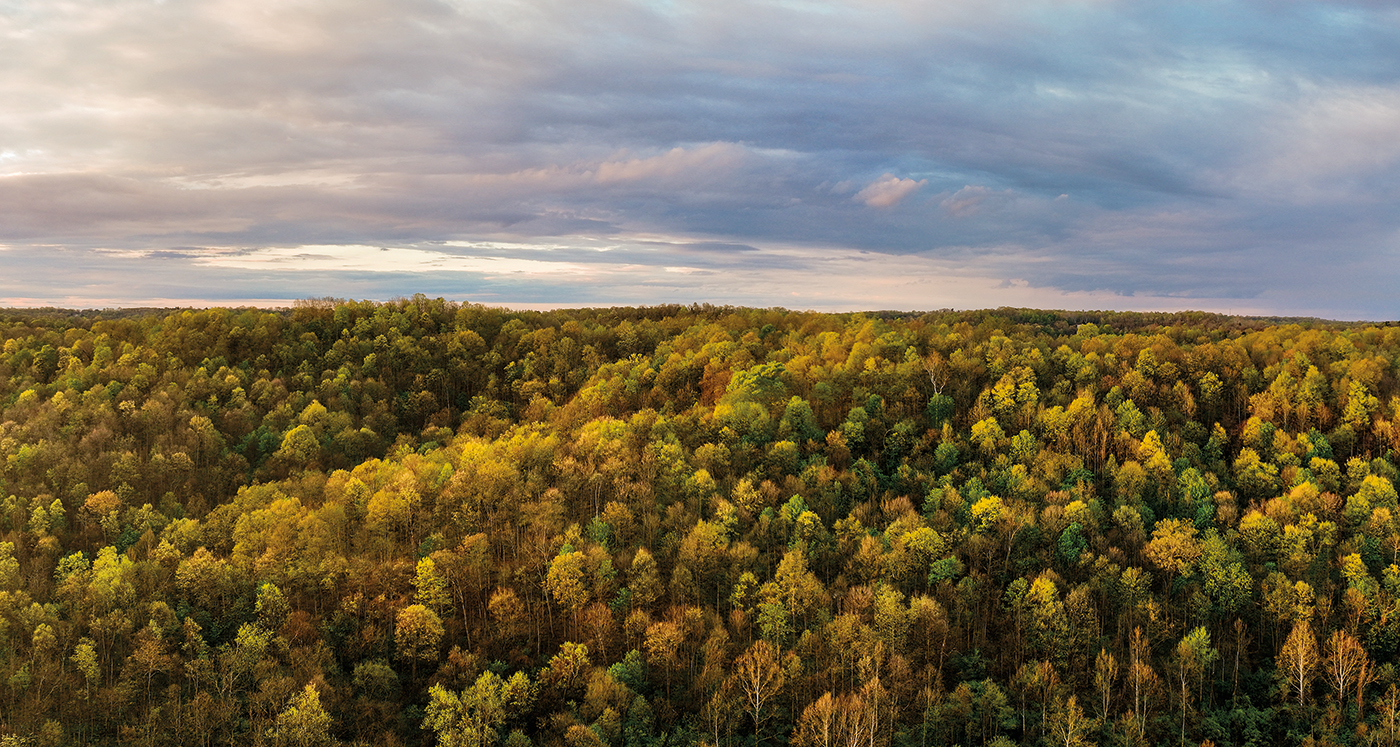
The sense of awe and wonder inspired by the sweeping vistas as one rounds the bend on Route 33 and Athens comes into full view is hard to replicate. Dotted by treetops and stately red brick buildings, the hills are alive, indeed.
Jen Bowman, BS ’97, MS ’00, knows that feeling well. While studying environmental geology and environmental geochemistry at OHIO, she took part in many tree plantings. Now, more than two decades later, she marvels at those same trees during her daily commute to the George Voinovich School of Leadership and Public Service, where she serves as the director of environmental programs.
“It’s a nice reminder that trees are a long-term solution,” she says. “They provide a riparian corridor and so much more—providing shade, taking carbon dioxide out of the atmosphere, providing habitat, being aesthetically pleasing and promoting well-being.”
The role of trees as an environmental solution is central to the ethos at the Voinovich School, which has been heavily involved in local reforestation efforts in recent years. One current focus is planting projects along stream and river banks, also known as riparian zones, which help create a vegetative buffer to improve water quality and promote biodiversity.
Read on to learn about three current projects that showcase how the Voinovich School’s efforts are branching out in support of the region.
Seeds of Sustainability

For the last 34 years, Athens has been a “Tree City USA” community for its continued commitment to urban forestry, and the Voinovich School is serious about its part in maintaining the designation, performing regular regional tree plantings and seeking key partnerships and funding opportunities for maximum impact.
“We’ve always had a focus on tree plantings, but I would say it has been a concerted effort since we received some funding from the Longleaf Foundation,” Bowman says, adding that an Appalachian Ohio Watershed Support grant from the Ohio Environmental Protection Agency has also been pivotal.
Tying it all together is an interactive ArcGIS StoryMap developed by Caroline Van Hook, BS ’21, during her time as a Voinovich Undergraduate Research Scholar (supported by Voinovich environmental specialist Nora Sullivan, MSES, MA ’16). The map details the school’s stream riparian planting projects, from Amesville Elementary to the Hockhocking Adena Bikeway.
One current point of interest is the section of the Hocking River directly behind the Athens Community Center on East State Street, where two tree plantings have taken place since 2022 to help stabilize the riparian corridor and replace invasive species with shade trees such as bald cypress and river birch. The project has brought all hands on deck, uniting the Voinovich School; the Athens Department of Arts, Parks and Recreation; the Athens Shade Tree Commission and more than 30 citizen volunteers.
“We need to make sure we are managing these spaces so people can use and enjoy them,” says Katherine Ann Jordan, who serves as Athens’ director of arts, parks and recreation. “[That section] was a huge amount of acreage that was not usable before we started restoring it. Now, I’m starting to see people take walks with their dogs or even go sunbathing.”

The riparian corridor along Columbus Road in Athens is one of many areas of focus for tree plantings. Photo by Ben Wirtz Siegel, BSVC ’02
Optimal Water Quality for All
Water law expert John Thorson once said, “Water links us to our neighbor in a way more profound and complex than any other.”
The Watershed Assessment, Restoration, and Planning (WARP) project puts those words into practice, with a goal to address water quality issues identified by the Ohio EPA in historically underserved areas of Appalachia, as identified using the federal EPA’s Environmental Justice Screening tool. Supported by an Ohio EPA grant, WARP will span three years and 32 counties in a collaboration between the local nonprofit Rural Action and the Voinovich School.
“Not all communities have the same level of access to resources—that’s where the WARP project comes in,” says Sarah Benton, a restoration project manager with Rural Action.
A key part of WARP will identify landowners who want to improve the streams on their property; as of late spring 2024, 30 have signed on. Furthering that effort will be HydroVIEW, a free online tool developed at OHIO that is being updated by Sullivan and Honors Tutorial College environmental studies major Blake Madden.
“We’re using data to target those areas that are impacted with sedimentation and sections of stream that are lacking a riparian buffer,” Bowman says. “Putting those two things together will help us target where we want to do the most beneficial planting.”
From there, Rural Action and OHIO will focus on strategies to offset sediment from erosion, acid mine drainage, agricultural runoff and more, starting with the planting of 1,000 native trees and shrubs along eroding streams that will benefit the most. Ultimately, Benton says, the teams hope WARP will kick off a project pipeline to address erosion issues in the future. “I’m excited about the trees we’re planting now,” she notes, “but also for the trees we’ll plant because of this project later.”
White Oak Restoration

In 2021, the University of Kentucky planted 8,000 young trees and saplings across 25 acres, creating the world’s largest repository of American white oak trees. But Athens may not be far behind.
OHIO is collaborating with the University of Kentucky, Rural Action, Sugar Bush Valley Farm and the White Oak Genetics and Tree Improvement Program (WOGTIP) to compare selective seed sources of white oak established side-by-side in Southeast Ohio. The goal is to determine which grow best, using those to begin replenishing the white oak population in light of high demand from producers of bourbon, wine and lumber.
“The bourbon industry is legally required to use oak from American sources, which began to outpace the ability of white oak to regenerate,” explains Eliana Balit, MSES ’24, who conducted their graduate practicum on the project. “White oaks are of particular interest because they host thousands of different species; if [abundance declines], there could be a huge environmental cascade effect.”
WOGTIP’s first Athens planting, established by the Voinovich School and Rural Action with partial funding via a donation from Speyside Bourbon Cooperage Inc. in Jackson, Ohio, took place in March 2023; since then, Balit and others have been taking regular measurements and photosynthetic readings to monitor the trees’ progress.
The work is poised to be particularly impactful in Southeast Ohio, where mature hardwood forests provide many ecosystem services. For associate professor Sarah Davis, Balit’s research advisor, it also speaks to the Voinovich School’s overall mission of making a positive impact on communities in the region.
“Developing best practices for sustainable forest management is really important for healthy communities,” Davis says. “If we think carefully about how we develop [our natural resources], we can grow an economy that doesn’t sacrifice the ecological benefits of the forests in the region.”
Feature photo by Ben Wirtz Siegel, BSVC ’02






